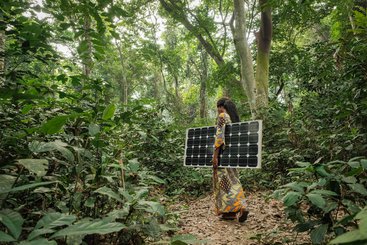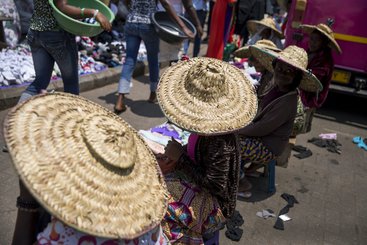Listen to political statements about economic development these days and there are lots of warm words about how it should be both ‘green’ and ‘inclusive’. There’s a future of secure work for people in tech-enabled industries and value chains that pay well and are kind to the planet. Right?
New research from ODI and the Climate and Development Knowledge Network (CDKN) scratches below the surface of pronouncements about ‘inclusive green economies’ to see how the most disadvantaged groups in society are included in literature, policy and practice of low-carbon development. Do these green economic visions include them?
It’s an especially relevant question to be asking on 'Gender Day' at COP27, when Shehnaaz Moosa will take to the stage to address climate justice for women and girls. Here’s an insight into what Shehnaaz will say about our research findings and what needs to happen next.
Our investigation focused on the status of women’s work in low- and middle-income countries, where climate impacts are biting hardest and the gender development gap is often high. We looked specifically at whether women’s empowerment is integrated into low-carbon economic transitions.
We weren’t quite prepared for what we found.
We didn’t expect to find a staggering five million passing mentions of the word ‘women’ in texts about green growth, low-carbon development and just transitions in the literature from 2015-22.
We also didn’t expect to find so little when we searched for deeper, meaningful discussions of women’s economic empowerment in low-carbon transitions.
We excluded texts that were only about the impacts of climate change on women including climate disaster impacts on women, or their role in adaptation. We looked for works that were centrally about ‘women’ or ‘gender’ and climate change mitigation (how to sustain economies while avoiding, cutting or locking up greenhouse gas emissions).
That left very little of substance on women’s ability to access secure, decent-paying, low-carbon work – either in theory or in practice.
Handful of pioneers
It is risky to exclude women from decision-making and implementation in low-carbon development. This is demonstrated by poorly-conceived schemes in the forest and land use sectors, where shutting women out has led to declines in their income, wellbeing and that of communities (see chapter 7 in Roots for the Future and evidence in our [1] gender and climate manual).
Some programmes learned and adapted rapidly to early documentation in the sector. The most inspiring propositions we found for gender-equitable, low-carbon and climate-resilient development were also in the agriculture and forestry sectors. For example, CGIAR has done progressive thinking and test-piloting in this area.
At whole-of-economy level, most discussion of ‘social inclusion’ in low-carbon transitions is vague on gender issues – and far short of actionable propositions.
Narratives about ‘just transitions’ have gravitated to how (principally male) workers in high emitting sectors such as coal mining must be compensated and retrained into secure, low-carbon jobs. Only recently have feminist and civil society-led networks in the Global South began pushing to reframe these narratives to consider women workers and especially in rural developing economies. They are also highlighting the undervaluation of women’s labour and imbalance in women’s and men’s roles in the care economy, particularly acute since the onset of the pandemic. Transforming labour markets is needed to fairly compensate unpaid care work, which is disproportionately taken up by women (noting that care work such as cooking needs often to be ‘greened’).
We identified just a few whole-of-economy low-carbon development plans that are fundamentally gender-equitable:
- Antigua and Barbuda’s Nationally Determined Contribution (NDC, 2021) commits to achieving SDG 5 on Gender Equality by “promoting low-carbon development where men and women’s contributions to climate change mitigation and adaptation are recognised and valued, existing gender inequalities are reduced”. The government promotes specific low-carbon opportunities for the effective empowerment of women. For example, there is a target to increase by 20% the number of women-led businesses implementing renewable energy and adaptation activities.
- The Republic of the Marshall Islands bases its climate policy on human rights, with a fully articulated commitment to women’s human rights: “Social considerations – including the differentiated impacts of climate change and the response initiatives on women, men and youth – should be systematically integrated into all climate change policy, planning and implementation.”
- Nepal’s NDC (2020) moves far beyond viewing women as beneficiaries. Its climate plan calls for the development of climate leadership by women and lower castes and ethnic groups who have traditionally been discriminated against – recognising the latent talents, capabilities and knowledge of these groups, who are ready to be equal partners in tackling climate change, humankind’s greatest challenge.
The snag: the world needs more integrated visions, like these pioneering countries, and low- and middle-income countries will need more concessional finance to help realise their visions.
International finance to fund low-carbon, climate-resilient development has been deeply insufficient overall, with high income countries consistently failing to meet their pledges – indicating the need for a step change in finance flows. Even then, gender and social inclusion issues are not prominent in countries’ finance asks: when the UNFCCC invited developing countries to highlight their climate finance needs, fewer than 10% flagged gender or specific communities as in need of specific targeting. Often the greatest needs and opportunities lie with empowering women from low-income and historically disadvantaged ethnic and social groups.
Our research was funded by Canada’s International Development Research Centre (IDRC). IDRC has embarked on an ambitious three year programme to fund research on women’s economic empowerment in low-carbon transitions, called Gender Equality in a Low Carbon World (GLOW). It’s a hugely important step – and will help populate a field where there is a dearth of material. However, far more investment is needed internationally on this agenda, for both evidence and action.
Recommendations for action
To delegates at COP27 and those developing budgets at home, we offer these specific recommendations on Gender Day:
Governments, multilateral organisations, international financial institutions:
- Do not treat gender equality and climate change mitigation goals and policies in isolation. The risks are too high. The missed opportunities are too great. Sustainable development depends on an integrated approach.
- Follow the lead of these pioneering governments. Unlock more concessional finance for implementing climate plans which have credible, actionable gender equality and social inclusion goals as a fundamental component (and recognising that adequate funding for inclusive, democratic assessment and planning processes is needed, as well as for implementation).
Research funders:
- Other research funders must fund more applied research on the intersections between gender equality, including women’s economic empowerment, and opportunities associated with low-carbon, green economies, following IDRC-GLOW’s lead.
For a deeper dive on why gender equality matters in low-carbon transitions, read our newly released brief Women’s economic empowerment: the missing piece in low-carbon plans and actions.




